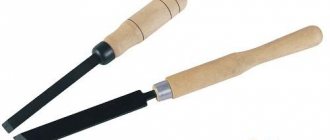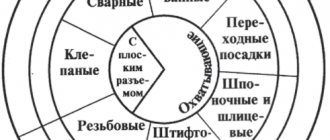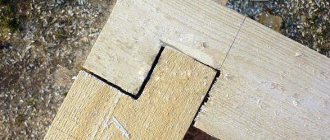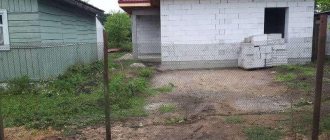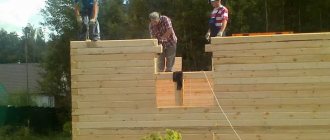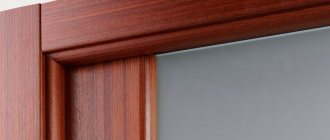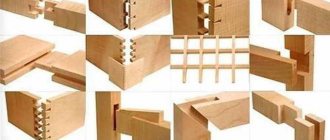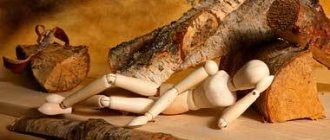Types of fasteners
Connecting bars at right angles is done using different methods. In fact, they are all divided into 2 types : with and without additional fasteners. This is due to the fact that the fastening for such joints is made of metal, and the properties of the latter are very different from the characteristics of wood.
The corner is a universal fastener. The bars are installed at 90 degrees at any length ratio, a metal corner is placed on one or both sides and secured with self-tapping screws, nails or screws. Since parts are produced with different angles between the plates, the bars can be secured at any desired angle.
Curly steel plates and iron staples can be used .
Assembly without corners is more common, although it requires more experience and skill. In this case, grooves are made in one or two bars and elements are inserted so that they form one whole. Due to the heterogeneous structure of the wood, a very large friction force occurs during adhesion, so the fastener is very reliable.
Gluing
Gluing wooden parts is carried out as follows:
- The surfaces to be glued are cleaned with a lint-free cloth, and rough spots are smoothed out with fine sandpaper.
- Using a cardboard stick, apply wood glue in an even, thin layer over all necessary surfaces.
- Surfaces coated with glue should be rubbed against each other. This will ensure even contact and strong adhesion.
- The parts need to be pulled together to ensure reliable retention at the joints. Measuring the diagonals will make sure the angles are straight. They must be equal. If this is not the case, the position of the elements needs to be corrected.
- The connection is strengthened by drilling pilot holes into which finishing nails or screws are driven. The screw heads must be recessed; for this, the holes must be bored out. The nails are deepened using a punch.
- Holes with nails are covered with wood putty. The holes bored out for the screws are closed with hardwood wooden plugs coated with glue. When the glue or putty has dried, the surface is sanded so that it is smooth and then varnished.
Longitudinal connection methods
The connection of wood blocks is possible in the longitudinal direction to lengthen the element and in the transverse direction. To join beams in length , the following technologies are offered.
- On the root thorn – a tenon and groove are cut out at the ends of the elements and connected. They are recommended to be shaped into a trapezoid - “ dovetail" This option eliminates the possibility of horizontal vibrations.
- Longitudinal on dowels – cuts are cut at the ends of the timber. Then a key is driven into the resulting groove. This part is made from a harder type of wood. For reliability, the key is lubricated with glue. Then the second beam is literally pushed onto the bar end-to-end with the first.
- "Half a Tree" – at the ends a more complex cut is made with an angle of 90 degrees and a depth of half the thickness of the timber. When connecting longitudinally, the clutch must be duplicated with a key. To do this, drill a hole at the joining point and, after aligning the beams, hammer a wooden dowel or dowel into it. You can duplicate the fasteners with metal staples.
- Oblique lock method – first, the ends of the bars are cut at an angle. The angle is small, so the cut is quite long. Then a rectangular recess is cut out in the upper part at a certain angle. The result is a combination of a recess and a protrusion. The same is done with the second beam. The elements are joined together, a hole is drilled for the fasteners and a wooden dowel is hammered into it. The method is complex, but the connection is very strong.
It is impossible to extend the beam using metal fasteners.
Placing the boards together
Boxes and components of mock-up cases are made from separate elements of wood. In this case, such types of connections as splicing, bonding or knitting are used. Joining can be called the joining of boards according to their parameters: thickness or width, in which the fibers of the wood material are located in parallel. The joining method is mainly used to create bulky structures.
To produce solid timber from individual components, nails, screws, glue, dowels are used, and when joining split timber, tires and wedges are used. A frequently encountered method of joining is the merging of elements by butting edges or faces together. The thinner the board during the joining process, the less likely it is to deform the material.
During the bonding process, it is important to take into account the placement of the annual layers on the wood. Compared to timber pieces that are joined by edges, blanks welded end-to-end with layers are much more stable and literally cannot be deformed. For detachable cases, the wood material is fused so that the growth rings are positioned with the convex part towards the parting plane, and for the construction of small detachable boxes - in the reverse order. A joint made by joining the boards into a fold and into a tongue and groove will not provide a strong stitched seam line. This type of joining is used to release goods without adhesion, used in conditions of high humidity.
Types of rallying:
- Rallying on a smooth fugue. The boards are pre-jointed, jointed, lubricated with glue, secured with clamps until dry;
- Cohesion with the introduction of additional connections. The boards are pre-aligned, and holes for the studs are drilled in the gables. Staples are driven in to increase durability;
- Bonding of load-bearing components. Joining boards into half a tree with an overhead part on the joining area of the reinforcing strips.
Corner connection methods
The angular connection of the beams to each other, on the one hand, is simpler, since the adhesion here is much better;
on the other hand, it is more complicated, since it involves cutting out many cuts and tenons of different shapes. There are 2 main technologies .
- “ Into the bowl” – more precisely, with the remainder. In this case, after fastening, some part of the beam remains outside the corner.
- “In the paw” - or without a trace. The angle looks straight.
The method is chosen taking into account the parameters of the material and the geometry of the entire building. For example, connecting rounded timber in the corners of a hut using the method without residue makes no sense.
With the remainder
This joining is done using locking grooves. Based on their number and type, there are 3 options .
- One-sided connection - a groove is selected on one beam with a cross-section equal to the cross-section of the second beam, but of less depth. The second element is simply inserted into the first. The method is simple and reliable.
- Double-sided - the cut is made in both bars and the groove is placed in the groove. This results in a double-sided fastening that is equally strong in both directions.
- Quadruple - change the shape of the bar closer to the end so that when connected they fit into the groove, but each subsequent element rises above the joining plane. In this case, the bars are connected and held by adhesion on 4 sides.
The more complex the docking method, the more preparation and calculations it requires.
Without a trace
You can fasten it at right angles without leaving any residue. There are many options here.
- “In half a tree” - as with a longitudinal connection, cuts are made at the ends of the bars to a depth of half the thickness. The material is placed into each other, groove into groove, and a strong bond is obtained. You can duplicate it with a dowel. In this case, another small cut is made in the upper part of the cut, and when joining, a key is driven into the resulting hole.
- Butt joint - simple fastening to brackets or plates. The wood is not processed, but simply laid with tight pressure on the ends and fixed with corners, sometimes even with self-tapping screws. Such fasteners must be duplicated with sealing material, since the joints cannot be made sufficiently tight.
- Root tenon - a groove is cut out in one element, any element, and a tenon of the same size is cut out in the other. When connected, the tenon fits into the groove, literally merging the elements. The technology ensures complete heat retention. Duplication with wooden panels is allowed.
- “Dovetail” - resembles the “half-tree” method, but the grooves are made trapezoidal. It is more difficult to calculate and make them, but this increases the adhesion area and the strength of the joint.
- “In the paw” - a cut is made at the end, which is a characteristic feature of such a connection. The grooves are made approximately half the thickness and with inclined planes. They are a little simpler than dovetail. This option is recommended to be used when constructing interior partitions, since this corner is easily ventilated.
Industrially, grooves and protrusions of more complex shapes are made into the bars. However, this requires special equipment.
Varieties
You may be interested in: A shoemaker without boots - the meaning of the expression
There are different types of joinery joints.
They are regulated by GOST 9330-60 and may belong to one of the groups specified in the standard. Connections can be as follows:
- By lenght. This allows you to combine parts that are adjacent to each other at their ends. This category includes splicing and extension. One of the most commonly used options is the spike type connection. There are several types of such combinations. What carpentry tenon joints do you know? Each carpenter has his own experience in using such joints.
- Along the edge. This type of combination is called cohesion. It is used for two or more workpieces to obtain a wide part.
- Angular end. The principle is similar to carpentry tenon joints. But in this case the parts converge at a certain angle. This technique is used in the creation of furniture.
- Angular medians. When creating such a connection, one part adjoins the other either at its end, or crosses it completely at a certain angle. In the first case, the connection is called adjacency, and in the second - intersection. This technique is used primarily to create shields.
- Box knitting. Used for connecting wide elements. Most often, such joints are made when assembling boxes and crates. This type of connection can also be end or middle.
The joining method is selected in accordance with the purpose of the product.
T-shaped beam connection
Such a connection is used when constructing walls inside a house and connecting them with external ones or with each other.
- Semi-pan - a protrusion is cut out on a perpendicular beam with one flat side and the other in the form of a trapezoid. The thickness is about half a block. The mating element has a groove of the same size and configuration.
- Key groove - a cut for a key is cut in the bars. When joining, the key is driven into the hole and held in place by the joint.
- Frying pan - the protrusion in a perpendicular block is made symmetrical in a trapezoidal shape. Docking is more difficult, since driving a perpendicular element into the main bar requires force. But the fasteners are reliable.
- A straight groove on the main tenon is a three-way joint. A groove of complex shape and with small grooves on both sides is cut out at the end of the perpendicular. Two beams of the main wall are joined to a perpendicular edge so as to form one plane on the outside. Retention occurs due to the entry of the spikes into the grooves of the perpendicular.
In a home, it is not recommended to replace the T-shaped joint with corner fasteners. The latter looks extremely unaesthetic.
Hidden Thorns
A rectangular tenon joint looks the neatest because the tenons are completely hidden.
Insert the tenons across the joining seam and as close to the inside of the frame as possible. The holes for the tenons are first drilled on one strip. Then, using marking pins inserted into the finished holes, the locations for drilling in another strip are determined.
There is another way of marking: small nails are driven into the bar, then they are bitten off with pliers. When two planks are tightly joined, the protruding tips will leave the necessary marks on the second workpiece.
Two or three tenons will add extra rigidity to any joint, even large, heavy frames.
Only with an exact match of the holes for the insert tenons can you obtain a perfect rectangular connection from two frame parts.
Recommendations for choosing a docking method
The joining method is chosen depending on the load on the node.
The choice of method depends on the load that will be placed on the node. The latter depends on weather conditions, the number of storeys of the building and the characteristics of the soil.
- If the corner or wall is mainly affected by compressive force, the “half-tree” method is preferable. It is quite simple and quite reliable in this case.
- If the wall is subject to tearing force, it is better to join it using a straight overhead lock or a root tenon. Dovetail will also work.
- For high bending loads, an “oblique lock” is chosen. It is more complicated, but allows you to level out multidirectional loads.
At the junction on the outside of the wall, the timber is rounded so that water does not accumulate in the grooves.
Selecting a groove on a wood cutting machine
When choosing a groove on a special wood-cutting machine, you must use a guide bar. This method is perfect for a long longitudinal groove. Thus, it is very convenient to make grooves for standard furniture shelf holders.
Thus, it is very convenient to make grooves for standard furniture shelf holders.
- Once you have been able to set the depth of cut and have adjusted the guide rail, you can safely cut the grooves. Since in this case any longitudinal groove will be at the same distance with another groove on the edge of the workpiece.
- On such a machine, you can also select a transverse groove, but the longer the part, the more difficult it will be to work with.
- The order of selecting grooves is: test cut and final cut.
How to glue wood. Technology
There are several ways to connect parts when gluing.
- Gluing wood into a smooth fugue - joining smooth parts without increasing the penetration area.
- Microthorn gluing – increasing the penetration area by 2.5 – 5 mm by creating a toothed relief on the part (using a milling cutter).
- Gluing onto a serrated tenon – increasing the penetration area by 10 mm by creating a serrated tenon.
- Tongue and tongue gluing (tongue and groove, dovetail, oblique tenon) - additional adhesion due to the groove connection.
Although in certain situations where special conditions of use are expected, groove and tenon joints are relevant, in most cases the parts are glued together using a smooth fugue. Modern adhesives penetrate deep into the structure and create a strong joint without additional wood removal.
How to glue boards together. Options
The wood to be glued must have a moisture content in the range of 8–12%, maximum 18%. If there is a need to glue wet parts, a special compound is used; during the hardening process, it draws moisture from the wood. When gluing blanks with different humidity levels, a difference of more than 2% is not allowed in order to avoid internal stress in the adhesive seam due to deformation of the wetter part. The temperature of the workpieces being glued varies between 15 - 20⁰С, so work is carried out in warm rooms (18 - 22⁰С). In the cold, most compounds crystallize, which leads to deterioration in the quality of gluing and complicates the process.
Final preparation of wood (planing, jointing, sanding) is carried out immediately before gluing in order to increase the permeability of the glue and avoid warping. It is important not only to select parts according to dimensions, structure and external data, but also to arrange them correctly.
- When gluing along the length, planks of only one type of sawing are used - tangential or radial;
- When gluing both along the length and width, alternating different parts of the wood is not allowed - the core is laid with the core, the sapwood (the young, outer part) with the sapwood;
- The annual rings of adjacent blanks made of boards or bars should be directed in different directions or at an angle to each other of 15⁰.
The standard thickness of furniture panels is 2 cm, but in order to glue wooden panels at home, when choosing boards for the panel, the expected waste during processing is taken into account, so the workpiece is selected up to 2.5 cm thick. The excess will be removed during the initial processing, when eliminating defects, and after gluing, when sanding the shield. If you cut a 5 cm thick board for a furniture panel, you get two blanks with the same texture and shade, which increases the decorativeness of the product. For panels, boards of wood of the same species, up to 120 mm wide, are selected, so that it is possible to properly process the edges of the panel; the length of the blanks must have a margin (2 - 5 cm).
Adhesives
The adhesives used to make laminated wood are divided into two main groups.
Synthetic - obtained on the basis of resins or polyvinyl acetate dispersions (PVA). They are characterized by increased strength of the resulting connection, moisture resistance, and biostability. Disadvantages include the presence of harmful substances that can be released into the environment during operation and further use. Compositions based on phenol-formaldehyde resins are “famous” for this. Modern PVA dispersions and their derivatives are non-toxic and are usually used in the domestic sphere and are considered universal for wood. The bulk of synthetic mixtures are ready for use. Epoxy glue needs finishing; to work with it, the hardener included in the kit is mixed with epoxy resin.
Natural mixtures - animal, plant, mineral. They are safe, provide a strong connection, but are produced in the form of semi-finished products that are prepared before use. How to glue wood with them: when preparing, you must strictly follow the instructions and observe the dosages, otherwise the quality of the glue will not allow you to obtain a strong connection. To prepare the glue, you usually need to dilute the powder concentrate with water to the desired consistency (it may require a certain period of swelling) or melt the solid particles. Direct exposure to fire is not allowed; a “water bath” is used, in which the mass with the addition of water, after swelling, melts to a homogeneous consistency.
How to glue wood
When gluing wooden surfaces, glue is applied to both parts in an even layer. The thickness of the layer depends on the type of glue, its consistency and the type of surfaces being glued - the thinner the wood, the thinner the layer. The glue should wet the part, but not excessively; when connecting the elements, an even bead should emerge outward. Glue drips are removed from the surface as soon as they set a little, using a scraper or spatula. Cured excess glue greatly spoils the appearance of the parts and complicates their further processing.
After applying the glue, the parts are kept for a certain period of time, this allows the composition to penetrate deeper, at the same time excess moisture evaporates, and the concentration of adhesives increases. During exposure, the seam should not be exposed to wind or become dusty. Some types of natural glue (bone, flesh) must be applied hot, instantly fastening the parts without soaking, since as the composition cools, the composition loses its properties.
How wood is glued - technology and subtleties
Making furniture with your own hands is becoming increasingly popular both due to the high cost of finished products and due to the large number of raw materials that have become freely available. At home, with a minimum set of appropriate tools, it is possible to assemble viable furniture that will serve well and delight you with its appearance. One of the most popular methods of joining wood is gluing, which allows you to obtain durable, monolithic parts. Bonding can be used as an independent fastener or as a backup when using external elements such as dowels, dowels or screws.
